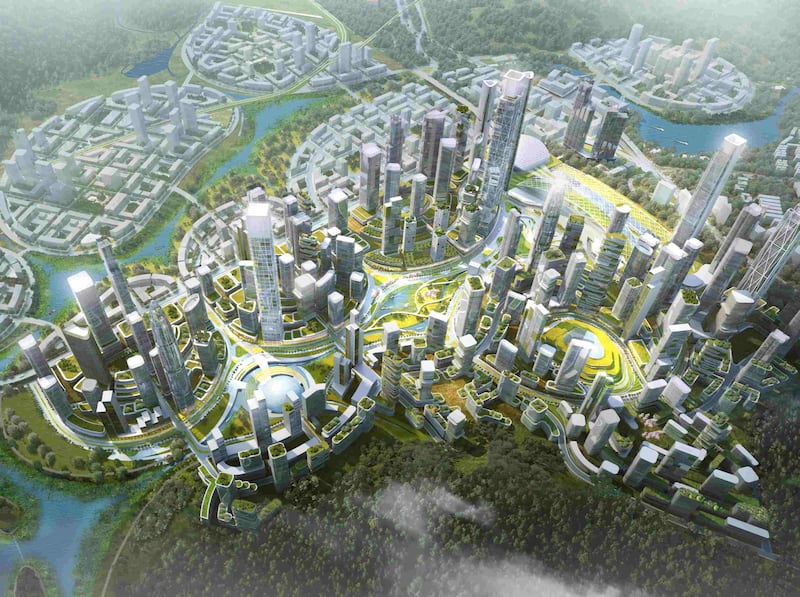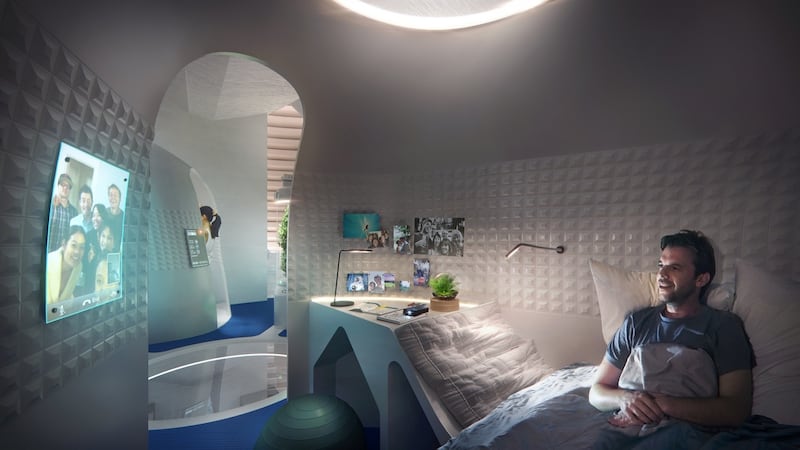Imagine a world where bacteria eats our waste, where homes can expand or contract in size depending on how many people inhabit them, where we commute by drone, and the hearth, once the heart of our homes, along with cemeteries and crematoria are relegated to the history books.
As a small island nation we operate an open economy that has led the way in the banning of plastic bags and smoking in public places. But when it comes to future-proofing, our reputation is less shiny.
Our population is expected to increase by two million by the year 2051, according to projected figures from the CSO, with at least 500,000 of those living within the greater Dublin area, where 1.4 million people already reside – 28 per cent of the population.

This will put a drain on all our resources. Starting with water, a precious commodity that we should be harvesting, says David Browne, managing director of RKD Architects and president of the RIAI.
In Ireland, where it rains an average of between 75cm and 100cm on the east coast and 100 cm to 140cm on the west coast, according to 30-year average forecasts by Met Éireann, this makes sense. Peter Kindel of American architecture practice Skidmore, Ownings & Merrill (SOM), partnered with National Geographic magazine earlier this year to look at rainwater harvesting and other big issues. Its thinking is that absorbent rain gardens and pools will be used in the future to collect and filter rainwater.
Getting from A to B
Transport has to become carbon-free and for now, in Ireland, this will for the most part be achieved via electric cars. Currently cars are parked for 95 per cent of the time whereas they should be in motion for 95 per cent of the time, Browne says. "An initiative in Copenhagen to reduce the space available to cars every year by two per cent means the city incrementally reduces car usage of roads. This leaves more room for trams, buses and cyclists."
“We need to look at transportation as a jigsaw that integrates all the pieces, the areas of expertise, be it bus, rail, car or taxi, working as one,” says John McCarthy, associate director and leader of intelligent mobility at Arup. “Mobility needs to become a service, and should be paid for like we currently pay for our other streaming services with all the forms of transport on offer talking to each other and relaying all that information to you, the customer.”
In the not too distant future flying taxis, vertical lift helicopters – volocopters – and drones may be considered more time-efficient ways to get around.
"How we make walking and cycling easier for city dwellers is a question that needs to be answered. We also need to make it easier for children to travel around on their own," says McCarthy. Bray-based Design Partners is already thinking about this and has developed a device called Vibris-Pro, which uses haptics, the sense of touch to create vibrations that "tell" a cyclist when to turn left or right for delivery couriers. "The cyclist will still have to read the road signs, but won't have their hearing compromised by the need to wear headphones to hear directions," says creative director Cathal Loughnane.
Food and drink
With vegetarianism on the rise more people should be encouraged to grow their own vegetables, says Browne. He has cabbage, kale and herbs in raised beds in his back garden and suggests that “landscaped courtyards in apartment blocks should be used to grow fruit and vegetables for residents’ own use.” Similarly they can be grown in sky gardens or below ground in obsolete underground car parks using hydroponics and LED lighting, as suggested by SOM’s Peter Kindel.
Pester power is changing things too. Kids will no longer bother you to buy them chocolate bars. They won’t allow their bodies be adulterated by sugars and fats. Your smart fridge could row in here too and frown on your white wine consumption levels (maybe even ratting you out to your life and health insurers).
The purchase of groceries and food, that you don't already grow yourself or within your own building, will become far more circumspect – the artificial intelligence system within the home will frown at any unnecessary food waste although the anaerobic bacteria in our bins will still love you for it. Irish firm WPN Energy is already piloting this service at The Yacht in Clontarf, Dublin 3.
Reuse
Even more futuristic is the idea of a circular economy that removes the need for waste altogether, says Léan Doody, associate director and digital property and smart cities leader for Europe at Arup. "This requires manufacturers in the supply and value chains to remove packaging and to make products that can be dismantled and repaired, rather than being sent to landfill."
The built-in obsolescence of current appliances and devices will require a rethink. We already have tech desks that can access appliances remotely to diagnose the problem and potentially repair it but she believes 3D printing could be used to download parts and/or encourage small repair shops which can print off and install parts for customers. “The whole business of repair has interesting implications for shops and for streetscapes,” she says.
Big data
Data will record everything we do and what we consume. "The waste and energy industries will benefit from such digital data around usage," Doody says. In a project in Singapore, where 80 per cent of the housing is provided by the state, its big question is how to manage building facilities – proper data can predict when lifts are about to break down and minimise disruption to residents.
Space
“The modern city will be dense and compact. It’s about densification and being more walkable, so you can get around without using a vehicle,” Kindel says. Currently in Ireland only 17 per cent of our housing stock is in apartments and the average height in Dublin is only two storey, Browne says. “If we could bring four to eight storeys throughout the city we would be able to accommodate all population growths.”
Prefabricated units will come of age – not the cold classrooms of our youth but rather as an affordable way to customise building. TopHat is a UK-based firm already rolling out a menu of unit options with a variety of floor and facade designs, customisation of internal layouts, and electric-powered, so zero-carbon in operation.
A Goldman Sachs investment of £75 million earlier this year signals changes for the entire house-building industry.
Space travel technology will be exploited by developers. The Tera, developed by New York-based AI Space Factory, was designed for long-term missions to Mars. It has an exterior 3D printed shell, constructed by an onsite robot that covers a wooden structure. The shell, made from a biopolymer basalt composite, developed from crops such as corn and sugar cane, is 50 per cent more durable than concrete and recycleable. This project is currently crowdfunding to help pay for the installation of one off-grid in upstate New York, where visitors will be able to stay from about $175 per night.


Homes that think for you
Many of us already use technology in the home. Siri or Alexa may switch on your lights, a phone app may boost the heating and get the shower running. Motion sensors will open and close doors for us. They will even raise or drop the toilet seat for you – ending that age-old battle between the sexes.
And while we laughed at the 1970s bidet brigade the idea of not having to use toilet paper in the future will finally become mainstream.
Will the future mean an end to vacuuming and dusting? No, says Michael Aldred, senior principal engineer at Dyson's robotics team, but you won't have to spend time doing it. "A robotic vacuum cleaner will identify habits, when you are and aren't in the home, and clean accordingly, learning from previous experience how many times a week it should clean, and on what setting."
Death
And yet despite all the tech advances there is still no fix to escape the grim reaper. So where will we all end up? Cemeteries have overstayed their welcome on valuable land. From its work with laboratories Browne of RKD Architects imagines a ghoulish Damien Hirst-esque shark-tank set-up, where bodies will be immersed in tanks, frozen, and their granulated particles fall to the bottom of the tank for retrieval – a more carbon-neutral option than cremation.
Incremental change is the way forward, Browne says. “It won’t be a science-fiction world but more a gradual improvement.”
















